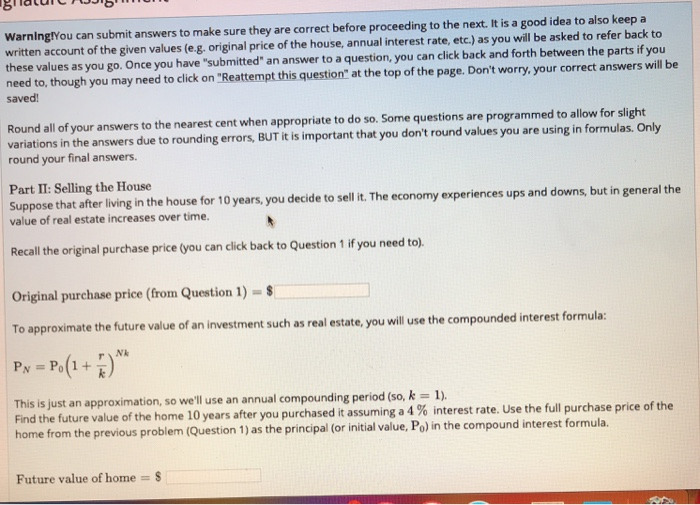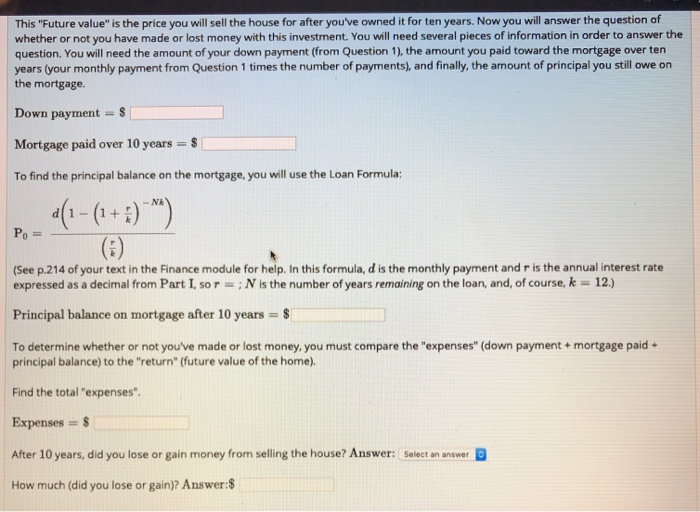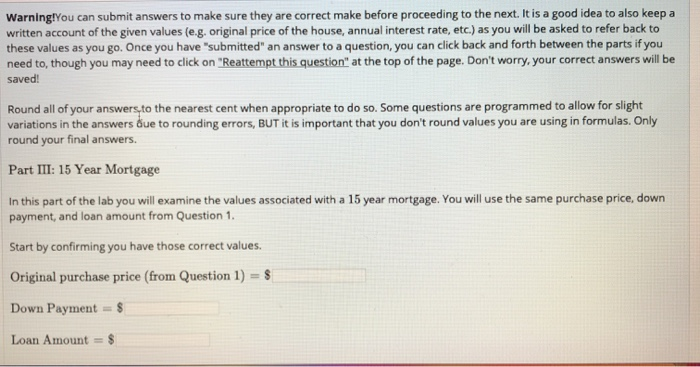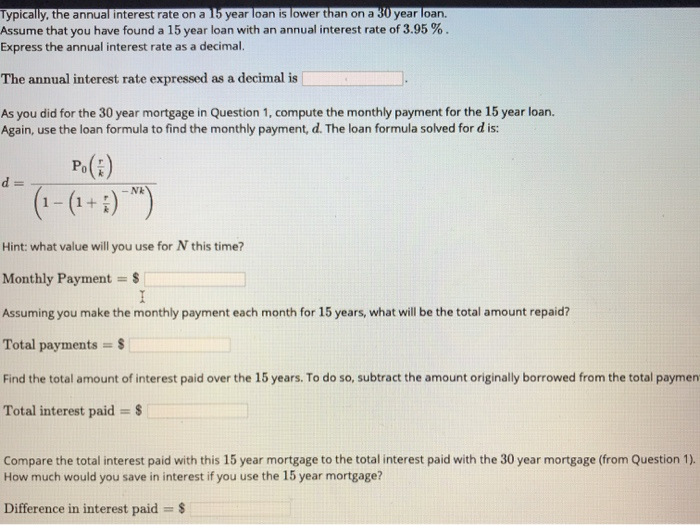Answered step by step
Verified Expert Solution
Question
1 Approved Answer
original price: $290700 WarningYou can submit answers to make sure they are correct before proceeding to the next. It is a good idea to also




original price: $290700
WarningYou can submit answers to make sure they are correct before proceeding to the next. It is a good idea to also keep a written account of the given values (e.g. original price of the house, annual interest rate, etc.) as you will be asked to refer back to these values as you go. Once you have "submitted" an answer to a question, you can click back and forth between the parts if you need to, though you may need to click on "Reattempt this question at the top of the page. Don't worry, your correct answers will be saved! Round all of your answers to the nearest cent when appropriate to do so. Some questions are programmed to allow for slight variations in the answers due to rounding errors, BUT it is important that you don't round values you are using in formulas. Only round your final answers. Part II: Selling the House Suppose that after living in the house for 10 years, you decide to sell it. The economy experiences ups and downs, but in general the value of real estate increases over time. Recall the original purchase price (you can click back to Question 1 if you need to). Original purchase price (from Question 1) - $ To approximate the future value of an investment such as real estate, you will use the compounded interest formula: Py = P. (1+) This is just an approximation, so we'll use an annual compounding period (so, k = 1). Find the future value of the home 10 years after you purchased it assuming a 4% interest rate. Use the full purchase price of the home from the previous problem (Question 1) as the principal (or initial value, Po) in the compound interest formula Future value of home = $ This "Future value is the price you will sell the house for after you've owned it for ten years. Now you will answer the question of whether or not you have made or lost money with this investment. You will need several pieces of information in order to answer the question. You will need the amount of your down payment (from Question 1), the amount you paid toward the mortgage over ten years (your monthly payment from Question 1 times the number of payments), and finally, the amount of principal you still owe on the mortgage Down payments Mortgage paid over 10 years = $ To find the principal balance on the mortgage, you will use the Loan Formula: a1 - (1+3) **) Po = (See p.214 of your text in the Finance module for help. In this formula, d is the monthly payment and r is the annual interest rate expressed as a decimal from Part I, SOT ;N is the number of years remaining on the loan, and, of course, k = 12.) Principal balance on mortgage after 10 years = $ To determine whether or not you've made or lost money, you must compare the "expenses" (down payment mortgage paid + principal balance) to the "return" (future value of the home). Find the total "expenses". Expenses = $ After 10 years, did you lose or gain money from selling the house? Answer: Select an answer How much (did you lose or gain)? Answer:$ Warning!You can submit answers to make sure they are correct make before proceeding to the next. It is a good idea to also keep a written account of the given values (e.g. original price of the house, annual interest rate, etc.) as you will be asked to refer back to these values as you go. Once you have "submitted" an answer to a question, you can click back and forth between the parts if you need to, though you may need to click on "Reattempt this question at the top of the page. Don't worry, your correct answers will be Saved! Round all of your answers to the nearest cent when appropriate to do so. Some questions are programmed to allow for slight variations in the answers Que to rounding errors, BUT it is important that you don't round values you are using in formulas. Only round your final answers. Part III: 15 Year Mortgage In this part of the lab you will examine the values associated with a 15 year mortgage. You will use the same purchase price, down payment, and loan amount from Question 1. Start by confirming you have those correct values. Original purchase price (from Question 1) = $ Down Payments Loan Amount = $ Typically, the annual interest rate on a 15 year loan is lower than on a 30 year loan Assume that you have found a 15 year loan with an annual interest rate of 3.95 %. Express the annual interest rate as a decimal. The annual interest rate expressed as a decimal is As you did for the 30 year mortgage in Question 1, compute the monthly payment for the 15 year loan. Again, use the loan formula to find the monthly payment, d. The loan formula solved for dis: d (1- (1 + 2) - Nk Hint: what value will you use for N this time? Monthly Payment = $ Assuming you make the monthly payment each month for 15 years, what will be the total amount repaid? Total payments = $ Find the total amount of interest paid over the 15 years. To do so, subtract the amount originally borrowed from the total paymen Total interest paid = $ Compare the total interest paid with this 15 year mortgage to the total interest paid with the 30 year mortgage (from Question 1). How much would you save in interest if you use the 15 year mortgage? Difference in interest paid = $ WarningYou can submit answers to make sure they are correct before proceeding to the next. It is a good idea to also keep a written account of the given values (e.g. original price of the house, annual interest rate, etc.) as you will be asked to refer back to these values as you go. Once you have "submitted" an answer to a question, you can click back and forth between the parts if you need to, though you may need to click on "Reattempt this question at the top of the page. Don't worry, your correct answers will be saved! Round all of your answers to the nearest cent when appropriate to do so. Some questions are programmed to allow for slight variations in the answers due to rounding errors, BUT it is important that you don't round values you are using in formulas. Only round your final answers. Part II: Selling the House Suppose that after living in the house for 10 years, you decide to sell it. The economy experiences ups and downs, but in general the value of real estate increases over time. Recall the original purchase price (you can click back to Question 1 if you need to). Original purchase price (from Question 1) - $ To approximate the future value of an investment such as real estate, you will use the compounded interest formula: Py = P. (1+) This is just an approximation, so we'll use an annual compounding period (so, k = 1). Find the future value of the home 10 years after you purchased it assuming a 4% interest rate. Use the full purchase price of the home from the previous problem (Question 1) as the principal (or initial value, Po) in the compound interest formula Future value of home = $ This "Future value is the price you will sell the house for after you've owned it for ten years. Now you will answer the question of whether or not you have made or lost money with this investment. You will need several pieces of information in order to answer the question. You will need the amount of your down payment (from Question 1), the amount you paid toward the mortgage over ten years (your monthly payment from Question 1 times the number of payments), and finally, the amount of principal you still owe on the mortgage Down payments Mortgage paid over 10 years = $ To find the principal balance on the mortgage, you will use the Loan Formula: a1 - (1+3) **) Po = (See p.214 of your text in the Finance module for help. In this formula, d is the monthly payment and r is the annual interest rate expressed as a decimal from Part I, SOT ;N is the number of years remaining on the loan, and, of course, k = 12.) Principal balance on mortgage after 10 years = $ To determine whether or not you've made or lost money, you must compare the "expenses" (down payment mortgage paid + principal balance) to the "return" (future value of the home). Find the total "expenses". Expenses = $ After 10 years, did you lose or gain money from selling the house? Answer: Select an answer How much (did you lose or gain)? Answer:$ Warning!You can submit answers to make sure they are correct make before proceeding to the next. It is a good idea to also keep a written account of the given values (e.g. original price of the house, annual interest rate, etc.) as you will be asked to refer back to these values as you go. Once you have "submitted" an answer to a question, you can click back and forth between the parts if you need to, though you may need to click on "Reattempt this question at the top of the page. Don't worry, your correct answers will be Saved! Round all of your answers to the nearest cent when appropriate to do so. Some questions are programmed to allow for slight variations in the answers Que to rounding errors, BUT it is important that you don't round values you are using in formulas. Only round your final answers. Part III: 15 Year Mortgage In this part of the lab you will examine the values associated with a 15 year mortgage. You will use the same purchase price, down payment, and loan amount from Question 1. Start by confirming you have those correct values. Original purchase price (from Question 1) = $ Down Payments Loan Amount = $ Typically, the annual interest rate on a 15 year loan is lower than on a 30 year loan Assume that you have found a 15 year loan with an annual interest rate of 3.95 %. Express the annual interest rate as a decimal. The annual interest rate expressed as a decimal is As you did for the 30 year mortgage in Question 1, compute the monthly payment for the 15 year loan. Again, use the loan formula to find the monthly payment, d. The loan formula solved for dis: d (1- (1 + 2) - Nk Hint: what value will you use for N this time? Monthly Payment = $ Assuming you make the monthly payment each month for 15 years, what will be the total amount repaid? Total payments = $ Find the total amount of interest paid over the 15 years. To do so, subtract the amount originally borrowed from the total paymen Total interest paid = $ Compare the total interest paid with this 15 year mortgage to the total interest paid with the 30 year mortgage (from Question 1). How much would you save in interest if you use the 15 year mortgage? Difference in interest paid = $ Step by Step Solution
There are 3 Steps involved in it
Step: 1

Get Instant Access to Expert-Tailored Solutions
See step-by-step solutions with expert insights and AI powered tools for academic success
Step: 2

Step: 3

Ace Your Homework with AI
Get the answers you need in no time with our AI-driven, step-by-step assistance
Get Started


